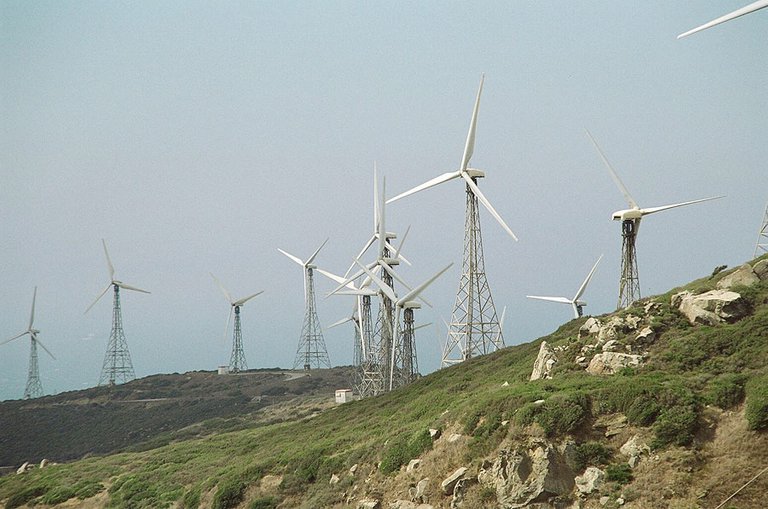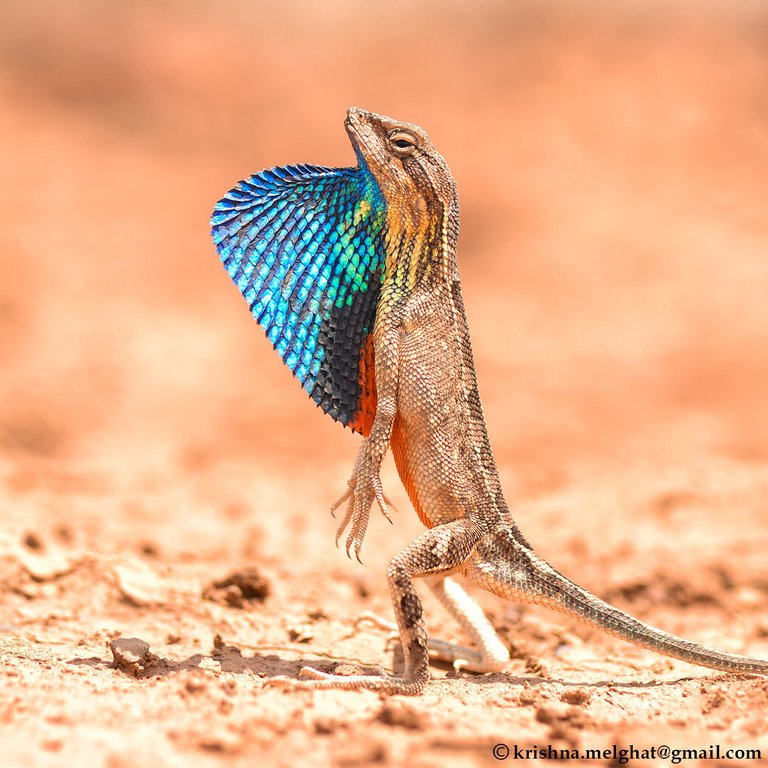Wind turbines have always been considered to be a good source of renewable energy, and while that is true, they come with their own set of problems. And while these problems might be next to nothing compared to the problems we get from other sources of energy such as energy from coal, they are still worth investigating, researching, and discussion in order for us to find better methods for the future.

A wind farm in Spain. Photo by Manfred Werner, posted with the Creative Commons Attribution-Share Alike 3.0 Unported license.
One of the big problems with wind turbines (and by extension wind farms) is that they kill a lot of birds when birds collide with the turbines. This has been well-documented and studied in many different parts of the world, and they seem to be pretty terrible for the birds in the area no matter where in the world you measure the bird mortality from wind turbines.
So while the increased mortality from wind turbines have been known for a long time, research that have looked at how this affects the entire ecosystem in the area with the wind farms have been more scarce. But luckily for us, research that look at the bigger picture of things seem to be more and more common, and a research group from Indian Institute of Science in Bangalore has recently published a paper called "Wind farms have cascading impacts on ecosystems across trophic levels", about the ecological consequences of wind farms in India. They didn't just look at how the wind farms affect the birds, but also took a close look at how this again affected the prey animals that were typically eaten by the birds that would be killed by the wind turbines.
The trophic cascades of the wind farms
The research paper looked at what happened with the rest of the local ecosystem when an area has wind farms, by comparing it to a similar area without wind farms, both in the Western Ghats in India. This area is considered a biodiversity hotspot, so the effects of wind turbines in this area might be more severe than the effects of the same wind turbines in an area considered to have less biodiversity.
One of the first things the research team found out was that the wind turbines themselves acts as kind of an apex predator that fills the slot even above the top predators in the area, since the wind turbines are responsible for killing a lot of the predatory birds in the area. There were four times as many raptors in the sample areas without wind turbines, which meant that the wind turbines acted as a rather effective apex predator that had a huge impact on the abundance of predatory birds.
This fact did of course have big impacts on the rest of the ecosystem, and one of the biggest changes they saw was that the natural prey animal of the raptors in the area, the superb large fan-throated lizard (Sarada superba), was more abundant in the plots with wind turbines.
But before we go deeper into the research, let's take a moment to appreciate just how beautiful this superb large fan-throated lizard really is!

Photo by Ashahar alias Krishna Khan, posted with the Creative Commons Attribution-Share Alike 4.0 International license.
The lizard has more than just a numerical response
When an organism grow in number because of changes on another trophic level, we typically call this a numerical response, and we see it all the time in the animal kingdom. If you kill all the wolves in an area, herbivores will have a swift numerical response in the next few years since there will be fewer sources of mortality. However, it's also possible for animals to have other responses, and the superb large fan-throated lizard had these as well.
One change noticed in the lizard was that they exhibited different behavior between the plots. They were generally much less afraid of other predators (measured by humans in the paper), and the researchers could on average get five times as close to the lizard found in the plots with wind turbines. This could likely have to do with the fact that these lizard never really had to learn to flee from predators in the first place, since they lived with very few raptors around.
This different was also noticed physiologically when the researchers measured the concentration of a stress hormone called corticosterone. This hormone plays a vital role in the energy expenditure of the lizards, and the lizards near the wind farms showed a lower level, signifying that they didn't spend as much energy on anti-predation behavior. Ironically other studies of animals living close to wind turbines have shown to give the animals there an increased level of this hormone, likely due to the stress from the noise from the turbines, but it seems like the lizards here has an overall positive effect since theirs was lower.
How does this affect the other trophic levels?
The research paper only looked at the effect on the predatory birds and the superb large fan-throated lizard, but I would say that it's very likely that the wind farms have effects that affects even more trophic levels. We know that the superb large fan-throated lizards must eat, so how does an increase in their abundance affect the number and species composition on insects in the area? I would assume that we would find fewer insects here, which again could affect other trophic levels. So there's a lot of room for further research about this, both in this particular ecosystem, as well as all other ecosystems affected by wind farms.
My point is that even the energy solutions that we humans deem to be sustainable will have changes on the ecosystem, either on a small or a large scale. I really enjoy research like this that shows these changes, and I hope we see more of this in the future. There's also a lot to be said about another type of renewable energy source that we use here in Norway; hydroelectric power. This is also considered to be renewable, but it has just as many, or maybe even more, changes to the local ecosystems that are affected by it. But that will be a post for another time!
Sources
Drewitt, A. L. & Langston, R. H. W. (2006). Assessing the impacts of wind farms on birds. DOI: https://doi.org/10.1111/j.1474-919X.2006.00516.x
Thaker, M. et al. (2018). Wind farms have cascading impacts on ecosystems across trophic levels.
Thanks for stopping by
I hope you enjoyed the post. Let me know if you have any questions or comments!
If you just posted a picture of the fan-throated lizard, that would have been a great post :) Gorgeous. But, seriously, reminds us not to be arrogant as we come up with 'solutions' for complex problems. I don't want to go all Eastern on you, but we really are part of a whole.
Yeah, it is an amazing lizard. I'm just glad I found a photo of it that I could share legally, since they seem to be pretty rarely photographed compared to most species I have written about in the past.
And you're right, it's nice that we sometimes get a reminder that even the solutions with the best intentions have bigger impacts than we expect them to. But it's also very important to remember that this changing ecosystem pays an enormously small price compared to what it would if they had begun mining for coal in this same region!
Really nice article @vaulth, I was about going to bed when your post came in and I decided to read through.
I think 🤔 that there may be another measures to protect birds from coming around a wind farm, one of the measures might be to protect the farm with net. I don’t know how possible that might be, it’s my thoughts though.
This is your friend @maxdevalue.
Thank you, @maxdevalue. Maybe a net would be a good idea. I wonder how this would affect the energy production though, or if it's even possible to create something like that. But it's a cool suggestion!
That is definitely one superb lizard XD
Renewable or otherwise anything that heavily modifies the area is going to impact whoever's living there so nice to see these studies being done.
Posted using Partiko Android
Yeah, exactly. I think we will likely see some research pointing out the problems with solar panels as well soon. Most people think they are free from problems, but I'm not so sure about that. Thanks for stopping by, @ryivhnn!
Awsome idea. Manabd gaste wal tamah chhui kya
What do you mean by that? What's the awesome idea?
If there are frequent collisions and make many birds become victims, I think tubin wind needs to be added to the safety features shaped like safety fingers like on a fan.
Hehe, maybe something like that could be useful. I have no idea how that would impact the potential energy output of the wind turbine though; it might really reduce it for all I know.
😂😎👍
Windmills are horrible investments. They could spin for 100 years and never equate the energy it took to make them. This going green movement is nonesense for the most part. Just like reducing the "carbon footprint"... I don't know who coined that term but it's very silly. Carbon is an element and one of the most abundant on Earth. Carbon dioxide and carbon monoxide are molecules... not elements. Last time I checked trees breathe co2. We could do with a lot more of it.
This post has been voted on by the SteemSTEM curation team and voting trail in collaboration with @curie.
If you appreciate the work we are doing then consider voting both projects for witness by selecting stem.witness and curie!
For additional information please join us on the SteemSTEM discord and to get to know the rest of the community!
That's badass.
Sure, I guess that's true.
Hi @valth!
Your post was upvoted by @steem-ua, new Steem dApp, using UserAuthority for algorithmic post curation!
Your UA account score is currently 5.184 which ranks you at #851 across all Steem accounts.
Your rank has dropped 3 places in the last three days (old rank 848).
In our last Algorithmic Curation Round, consisting of 425 contributions, your post is ranked at #50.
Evaluation of your UA score:
Feel free to join our @steem-ua Discord server
The researcher really did a wonderful job. The truth still remains everything or action we take will always have its good and bad side.
@manka
content creator